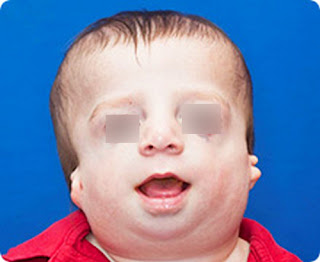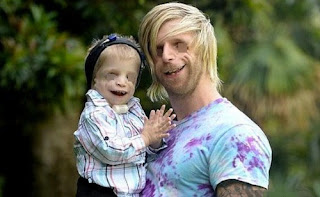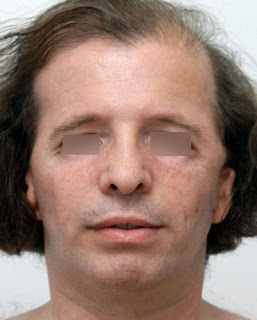What is Treacher Collins syndrome?
It is a rare genetic condition affecting the head and face. It is also called mandibulofacial dysostosis. (1)Treacher collins syndrome pictures
Picutre 1: A child with Treacher Collins Syndrome (TCS).
Image source: www.seattlechildrens.org
Picture 2: TCS, an inherited condition as shown an image of a parent and a child with treacher collins syndrome.
Image source: i.dailymail.co.uk
Picture 3: A severe form of treacher collins syndrome.
Image source: i.huffpost.com
Picture 4: A closer look on the cartographic image of a child with treacher collins syndrome.
Image source: syndromepictures.com
Picture 5: An adult with treacher collins syndrome.
Image source:www.craniofacial.org
Picture 6: A patient with treacher collins syndrome post surgery.
Image source:www.craniofacial.org
Characteristics of Treacher Collins syndrome
- down slanting of the eyes
- lower eyelids are notched
- underdeveloped/absence of cheekbones
- small and slanting lower jaw
- malformation of the ears (1, 2, and 3)
What causes Treacher Collins syndrome?
It is caused by an abnormal change in the chromosome 5, which is the very same chromosome that affects the development of the face. It is an inherited condition. Studies show that if the parent has Treacher Collins syndrome, there is a 50% chance that the child will inherit it. (3, 4)
Other possible problems related to Treacher Collins syndrome
- Eating difficulties
- Breathing problems
- Possibility of hearing loss secondary to earn abnormality
- Susceptibility to eye infection
- Possibility of cleft palate (4, 5)
Prevalence rate
Treacher Collins syndrome affects the male and female population equally. As mentioned above, it is a very rare condition affecting one out of 10,000 to 50,000 population. (5)Diagnosis
A thorough clinical evaluation is made to accurately diagnose the condition of the patient. The doctor will check for the presence of craniofacial abnormalities. X-ray studies are performed to thoroughly check the condition of the patient. If deemed necessary, molecular genetic testing is performed to confirm the diagnosis. (6, 7)Is there a treatment for treacher collins syndrome?
Unfortunately, there is no exact cure for Treacher Collins syndrome. What medical experts can offer is symptomatic relief that is apparent to each person. The patient's case is handled by a team of healthcare professionals including pediatrician, surgeon, ophthalmologist, psychologist, and allied healthcare workers.The patient's condition is closely monitored to check for any abnormalities that are associated with the disorder. Early intervention is a must to make sure that the patients with Treacher Collins syndrome will be able to reach their potential. Other supportive approaches include speech therapy, social support, and genetic counseling.
when deemed necessary, a surgical procedure is done such as the reconstruction of craniofacial malformations. If the patient has a cleft palate, it should be corrected surgically. The same thing goes for other facial malformations. (2, 4, 6, and 7)
Treacher Collins syndrome life expectancy
People with Treacher Collins syndrome grow as normal functioning adults. They have a normal intelligence. If the complications are handled properly, their life expectancy is the same as the general population. (5, 6)
References
- https://rarediseases.info.nih.gov/diseases/9124/treacher-collins-syndrome/cases/48356
- https://www.medicinenet.com/treacher_collins_syndrome/article.htm
- https://www.thinkgenetic.com/diseases/treacher-collins-syndrome-7517/living-with/6548
- https://en.wikipedia.org/wiki/Treacher_Collins_syndrome
- https://emedicine.medscape.com/article/946143-overview
- http://www.seattlechildrens.org/medical-conditions/chromosomal-genetic-conditions/treacher-collins/
- http://www.orpha.net/consor/cgi-bin/OC_Exp.php?Lng=EN&Expert=861







